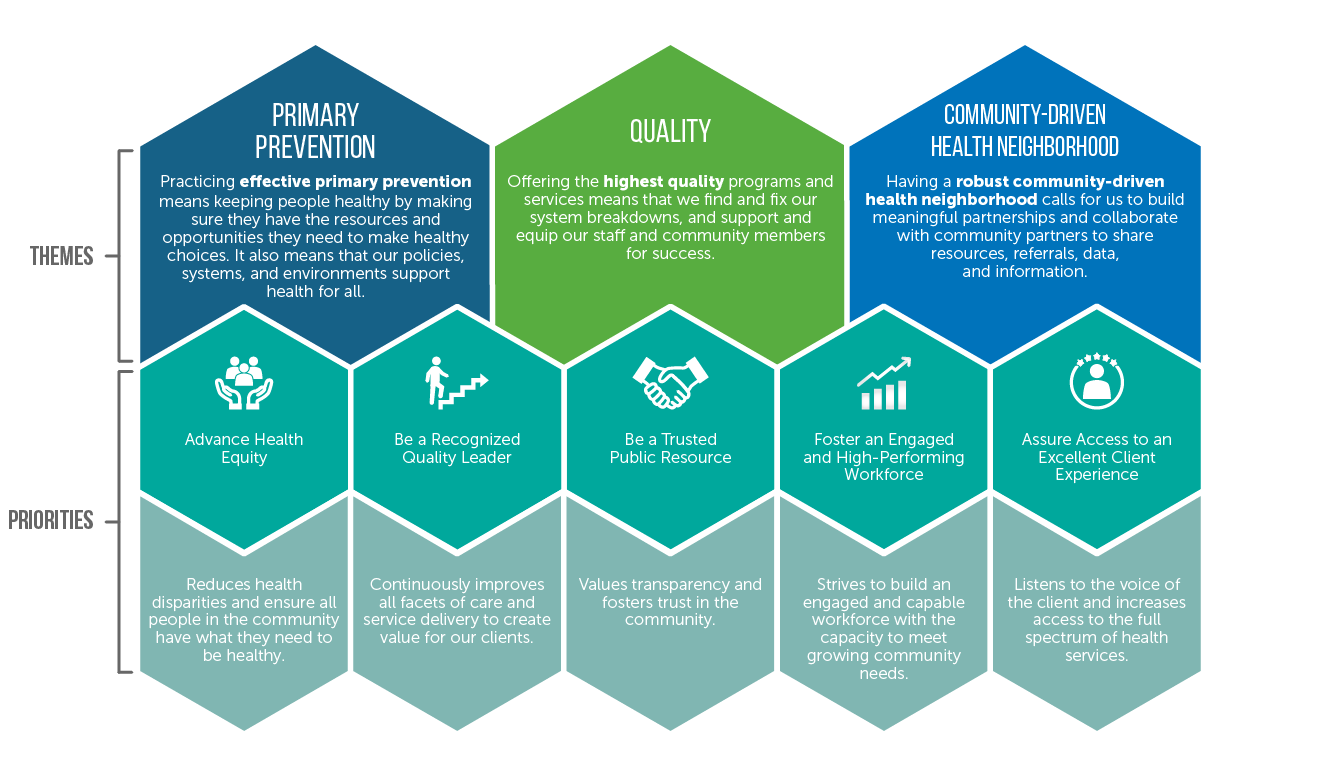OneLCHD Strategic Plan
An open, adaptive plan with a 25-year vision, complemented each year by an Annual Action Plan.
This strategic plan is an open, adaptive plan with a 25-year vision, complemented each year by an Annual Action Plan.
We have continued to change our approach to strategic planning because we needed to make real changes in how we work together as organization, not just what we are working on programmatically. Making an impact on the health of our organization as perceived by the community we serve requires strategic, coordinated efforts across our entire organization.
Achieving the level of alignment and strategic thinking necessary for this change would be nearly impossible with a traditional plan. We needed to build a plan that addressed these four challenges head-on.
Open
A transparent strategic planning process that invites staff at all levels and governing board members to participate.
The Challenge: Plan developers and implementers have different expectations, priorities, and needs.
A survey of 233 LCHD staff found that 8 out of 10 staff reported no involvement in previous plans. Only 4% of frontline staff indicated they were involved in the development of prior plans, and only 6% indicated they were involved in their implementation. In over 75 individual staff interviews, many staff expressed frustration in connecting the objectives to their day-to-day work and had trouble “seeing themselves” in the plan.
Our Answer: Crafting an open, inclusive plan that reflects the voices of staff at all levels.
This plan is by staff—8 out of 10 staff reported interest in helping in the planning process, so all LCHD staff had the opportunity to participate. Frontline staff know better than anyone else where their biggest programmatic challenges are and what the community, they serve needs, so they served as the central players in crafting the plan’s objectives. Including the voices of all staff—from directors to clerks—in OneLCHD’s development ensured that the plan’s focus and objectives are meaningful, relevant, and reasonable.
This planning process was also made transparent to all. One-on-ones, surveys, video updates, town halls, presentations at staff meetings, and web updates kept staff informed and updated on plan progress, including updates on our Annual Action Plans.
Adaptive
A flexible plan that allows us to incorporate new information or change directions as needed.
The challenge: Sticking to a rigid plan written years ago is extremely challenging when funding, political, demographic, or social contexts can change rapidly.
With traditional plans, an organization sticks to the published plan for the duration of the planning cycle, even if realities shift or proposed strategies fail. LCHD regularly encounters new policy changes, environmental challenges, funding opportunities, or even a pandemic. We need to be able to change course if necessary.
Our answer: Creating an adaptive plan with flexibility to address and incorporate new realities.
The design of this plan allows us to pivot and rapidly respond to new information or challenges. It allows us to change our approaches and priorities when we discover what we are doing is not working. It also allows us to incorporate new perspectives or partners as they emerge. This plan is a living document that can be modified or adapted as needed to best serve our community.
25-Year Vision
A long-term vision allows us to plan and act according to changing organizational systems and cultures.
The challenge: Organizational culture, health outcomes, and community relationships take years—if not decades—to change.
We believe it takes longer than three years to produce significant changes in culture or health outcomes. We set ourselves up for failure when we set unreasonable expectations.
Our Answer: Using a 25-year vision that more accurately reflects the necessary pace of changing systems and cultures.
A 25-year vision encourages long-term planning, which helps us anticipate and prepare for unknown futures. Having a 25-year vision does not mean that we have set every activity for the next 25 years. It simply means we are using a more realistic timeline for measuring our progress and success. Our strategic plan does not include any information on how we operationalize the plan (that comes in the Annual Action Plan). It instead focuses on aligning all LCHD staff towards shared long-term vision and goals that address the root causes of our challenges.
Annual Action Plan
A breakdown of what we must do each year to achieve our strategic objectives.
The challenge: With traditional strategic plans, frontline staff are expected to carry out the plan with little guidance or accountability.
Traditional strategic plans task frontline staff with implementing the plan, even when the plan offers little guidance on what they need to do to succeed. Meeting the predetermined objectives may not be feasible given the daily realities staff encounter. It can also be challenging to stay on track if staff are not coordinating or tracking their work.
Our answer: Having frontline staff work alongside leadership to determine a realistic annual plan.
Every year, LCHD staff sets an Annual Action Plan for achieving our Objectives. Staff from across the agency collaborate to determine the specific activities (what we do), key results (how we measure success), and who is accountable for each activity. This ensures that the activities of each program account for their priorities and capacities and that their key results reflect the impact of their work. By setting small, realistic steps in the right direction, we are positioned to move steadily toward success.
MISSION
Promoting the health and well-being of all who live, work, and play in Lake County
Vision
Healthy Choices.
Healthier People.
Healthiest Communities.
Values
- Outstanding Customer Service
- Outstanding Professional Competence
- Outstanding Teamwork
- Fiscal Responsibility


